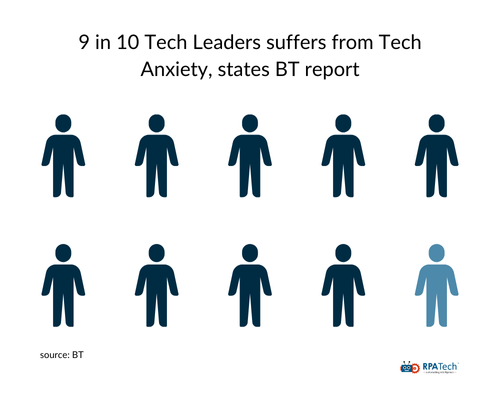With the advent of GenAI and ChatGPT, the digital landscape is evolving at a rapid pace. And businesses are racing to stay ahead of these technological advancements to stay competitive. Thus, increasing the urgency to adopt emerging technologies, so does the anxiety among business leaders tasked with implementing these solutions.
A recent report by BT reveals that a staggering 9 in 10 business leaders experience what they refer to as “bytemares” – fears that the relentless pace of technology is too overwhelming to manage effectively. This “tech anxiety” can be particularly pronounced among leaders in charge of steering digital transformation initiatives.

Tech anxiety stems from various factors, including cybersecurity threats, the pressures of adopting emerging technologies, the challenges of managing vast amounts of data, and regulatory compliance issues. Understanding the roots of tech anxiety, its impact on businesses, and how to manage it are important for leaders looking to navigate the complex world of digital transformation.
In this blog, I’ll walk you through the meaning of tech anxiety, what causes tech anxiety among leaders, its impact on business decisions, while offering actionable strategies for overcoming it. So, let’s first start with understanding the meaning behind the phrase “Tech Anxiety.”
What is Tech Anxiety?
Tech anxiety refers to the concerns and uncertainties that business leaders face as they strive to keep pace with rapid advancements in technology. The need for a robust digital transformation strategy is evident: 94% of senior leaders across various industries report having such a strategy in place. However, the fast-evolving nature of technology, coupled with high costs, complexity, and regulatory concerns, leaves leaders questioning how best to implement and sustain these changes.
In a recent BT study, 81% of leaders agreed that continued investment in digital transformation is essential for business success. Yet, the same leaders also expressed growing anxieties about cybersecurity, data management, and AI ethics.

But what causes this Tech Anxiety among leaders? Let’s see in the next section.
Causes of Tech Anxiety Among Leaders
Understanding the causes of tech anxiety can help leaders pinpoint areas that need attention. Here are some of the top concerns:
- Cybersecurity: With cyber threats becoming more sophisticated, cybersecurity is the top anxiety factor, with 24% of leaders citing it as a critical concern. Global cyberattacks rose by 7% in early 2023, emphasizing the need for robust defences and leaving leaders anxious about potential breaches that could harm their companies’ reputations.
- AI & Machine Learning: The disruptive nature of AI and machine learning is also a primary source of concern, especially as these technologies advance rapidly. 35% of leaders who cited AI as a source of anxiety attribute this to the technology moving too quickly, raising fears about ethical implications, such as job displacement, data privacy, and potential AI biases in the algorithms.
- Data Trust & Security: Leaders are increasingly dependent on data to make strategic decisions, yet only 30% of leaders fully trust their company’s data. This lack of trust can paralyze decision-making, create bottlenecks, and lead to suboptimal outcomes.
- Sustainability and Compliance: Growing regulatory pressures around sustainability add another layer of complexity. With sustainability initiatives under intense scrutiny, leaders are concerned about navigating compliance requirements effectively.
The Impact of Tech Anxiety on Business Decisions
Tech anxiety affects more than just the mental well-being of executives; it also influences business decisions and can impact growth. When leaders are hesitant to fully invest in digital transformation initiatives, they risk falling behind competitors who are willing to take those technological leaps. In fact, 58% of business leaders still plan to increase their digital transformation budgets this year, despite the anxiety surrounding these initiatives.
However, tech anxiety can also delay innovation, cause organizations to make reactive rather than proactive decisions, and hinder the successful implementation of strategic plans. Left unaddressed, tech anxiety may result in a costly cycle of halting and restarting projects, which affects productivity and employee morale.
Addressing Cybersecurity Concerns
Cybersecurity remains one of the most immediate concerns for leaders. As cyberattacks become more frequent and sophisticated, companies must adopt a multi-layered approach to defend against potential breaches. This is especially critical as the financial cost of cyber incidents continues to rise, with the average cost of a data breach reaching $4.2 million for organizations using private clouds.
Practical Steps to Manage Cybersecurity Anxiety:
- Invest in Cybersecurity Training: Regularly train employees on cybersecurity best practices to reduce human errors that often lead to breaches.
- Implement Multi-Factor Authentication (MFA): MFA adds an extra layer of security and is one of the most effective ways to protect against unauthorized access.
- Consider Cybersecurity Insurance: With the rising costs of breaches, cybersecurity insurance can help offset the financial impact and give leaders peace of mind.
Navigating the AI and Machine Learning Revolution
AI and machine learning hold transformative potential for many industries, but they also carry inherent risks and uncertainties that contribute to tech anxiety. Concerns around job displacement, ethical decision-making, and privacy are at the forefront of leaders’ minds, especially as AI becomes more integrated into business operations.
Approaches to Address AI-Related Anxiety:
- Establish Clear Governance: Develop AI governance frameworks that ensure transparency, accountability, and ethics in AI-related decisions.
- Emphasize Data Quality: Since AI relies on vast amounts of data, ensure that your data is accurate, secure, and unbiased to minimize risks.
- Prepare for Workforce Transition: Invest in upskilling programs to help employees transition into roles that complement AI rather than compete with it.
The Importance of Data Confidence and Management
Data has become the foundation for informed decision-making in business, but many leaders lack confidence in the data they rely on. Only 30% of leaders fully trust their data, leading to tech anxiety about the reliability of insights derived from data analysis. Poor data quality can lead to missed opportunities, hinder competitive advantage, and delay business growth.
Best Practices for Boosting Data Trust and Security:
- Centralize Data Governance: Establish a single source of truth within your organization by centralizing data sources and standardizing data processes.
- Regularly Audit Data Quality: Regular data quality checks can help identify inconsistencies and improve overall data reliability.
- Invest in Data Security Measures: Protect sensitive data by implementing encryption, access controls, and monitoring systems.
Investing in Digital Transformation as a Path Forward
Investment in digital transformation remains a priority, despite the challenges and uncertainties that come with it. The BT report reveals that 84% of business leaders feel that economic conditions impact their short- and long-term digital transformation plans. However, the majority recognize that to maintain competitiveness, digital investments are necessary.
To make digital transformation a smoother journey, consider the following investment strategies:
- Adopt an Agile Approach: Agile project management allows for flexibility and rapid adjustments, helping organizations adapt to changing conditions more easily.
- Focus on Scalability: Prioritize technologies that can grow with your business to avoid costly re-investments.
- Incremental Changes Over Large Overhauls: Smaller, gradual improvements are often easier to manage and can deliver quick wins that reduce tech anxiety.
Practical Tips for Tech Leaders for Overcoming Tech Anxiety
While tech anxiety may seem overwhelming, leaders can take proactive steps to manage it effectively. Building resilience, aligning tech initiatives with business goals, and fostering a culture of adaptability can go a long way toward mitigating these challenges.
Actionable Strategies for Managing Tech Anxiety:
- Invest in Staff Education and Upskilling: Addressing the digital skills gap within your workforce can empower teams and reduce anxiety around complex tech initiatives. Upskilling employees can also boost confidence and morale, creating a more resilient organization.
- Establish Clear ROI Metrics: One way to mitigate anxiety around tech investments is by setting clear, measurable goals that demonstrate ROI. By tracking progress and celebrating milestones, leaders can create a positive narrative around digital transformation.
- Prioritize High-Impact Areas: Focus on high-impact areas such as AI, cybersecurity, and customer experience to ensure that resources are being used where they can have the most immediate and tangible benefits.
- Create a Tech Roadmap: Developing a roadmap that outlines short-term and long-term goals helps align tech initiatives with overall business strategy and reduces the uncertainty that drives tech anxiety.
Conclusion
As the world of technology continues to evolve, tech anxiety will likely remain a common experience for business leaders. However, rather than allowing these concerns to stifle growth, leaders can view tech anxiety as an opportunity to build resilience, enhance adaptability, and position their organizations for long-term success.
Through careful planning, investment in cybersecurity, and a focus on building data confidence, leaders can turn tech anxiety into a driving force for digital transformation. Embracing change, preparing for the unexpected, and fostering a culture of innovation will help organizations not only survive but thrive in an increasingly digital world.




